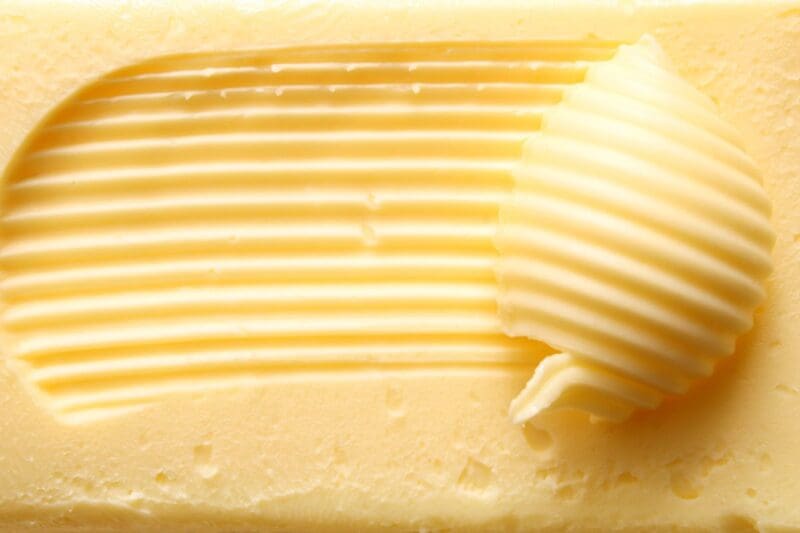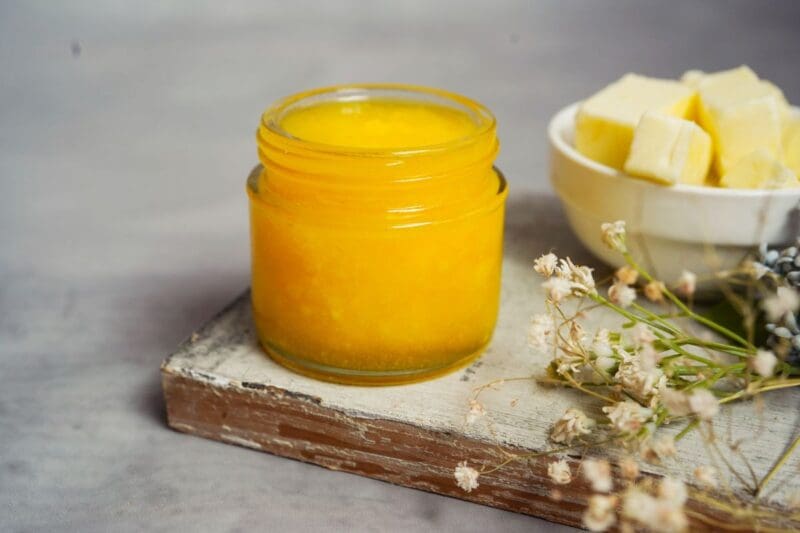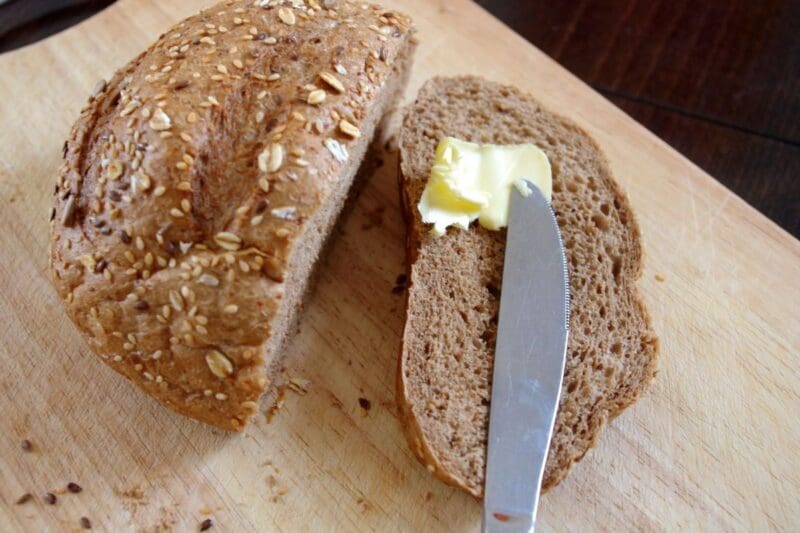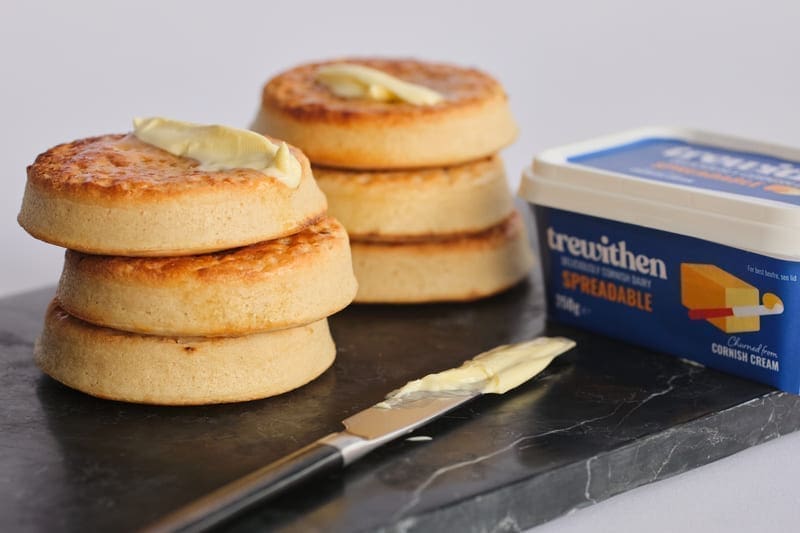Table of Contents
We’ve all been there – reaching for butter straight from the fridge only to find it’s too hard to spread, ruining our morning toast by tearing it to pieces! As Cornwall’s favourite butter-making experts, we understand this frustration. We have been crafting quality dairy products for generations, and we’re excited to share with you our tips on how to make butter spread while maintaining that rich, creamy taste that we all love.
The Science Behind Spreadable Butter
In a nutshell, butter is a blend of water droplets suspended in butterfat, with some milk proteins mixed in. This unique composition is what gives butter its distinctive texture and mouthfeel, but it’s also what makes its consistency so temperature-dependent.
Why Cold Butter Doesn’t Spread
When butter is refrigerated below 8°C, the cold temperature essentially freezes the fat molecules in place, preventing them from moving freely against each other and locking them in place. This is why that knob of butter straight from the fridge refuses to glide across your toast and instead turns your bread into a torn mess.
The Perfect Spreadable Consistency (Temperature Guide)
Finding the ideal temperature for your butter is the key to learning how to make butter spread more easily.
- 0-5°C: Butter is rock hard – great for recipes using butter where you need to cut it into flour, but impossible to spread
- 8-10°C: Firm but beginning to yield – suitable for decorative butter curls
- 15-18°C: The “spreadable sweet spot” – soft enough to spread easily without melting
- 21-26°C: Soft and slightly melty – perfect for mixing into compound butters
- Above 27°C: Melting point – butter loses its structure and melts into a golden liquid consistency.

How to Make Butter More Spreadable, Fast
If you don’t have a cook’s thermometer to hand and are rushing out the door to work, how can you make butter spread more quickly? Here are some real-life top tips to help make your butter spread more easily, fast.
The Room Temperature Method
Try cutting your butter up so that it reaches the ideal spreading temperature more quickly. A whole block of butter might take 1-2 hours to soften properly, but smaller pieces (about 1-2 tablespoons) can be ready in just 20-30 minutes.
Top tip: Place your butter on a plate rather than leaving it in the wrapper, as the air circulation will help it to come to room temperature more quickly.
The Grating Technique for Instant Spreadability
When you simply can’t wait, this clever butter-spreading hack works wonders!
Take your cold butter straight from the fridge. Using a standard cheese grater, grate the amount of butter you need onto a plate or directly onto your bread/toast. The increased surface area of the grated butter allows it to soften almost instantly. This technique is particularly useful for baking when you need room-temperature butter quickly for recipes like biscuits or cakes.

The Warm Utensil Hack
A simple yet effective method we love at Trewithen Dairy is simply using a warm butter knife to spread your butter. Run your knife under hot water for 30 seconds, dry it off, and then use the warmed knife to slide through your cold butter. The heat from the knife will slightly warm the butter edges as you cut, making spreading much easier. This method works particularly well for serving butter at the dinner table when hungry guests are eagerly waiting.
Microwave Method: Dos and Don’ts
While microwaving your butter offers speed, it requires careful attention to avoid turning your butter into a puddle. Cut into small, even pieces for even warming and microwave in short bursts – just 5 seconds at a time should do it.
NB- As you know, microwaves and metal don’t mix (!) so if your butter has foil or metallic wrapping, remove every bit to avoid sparks.
Common Mistakes When Softening Butter
We’ve seen plenty of butter mishaps over the years. Even experienced home cooks sometimes struggle with achieving that perfect spreadable consistency. Being aware of these common pitfalls can save your butter—and your breakfast!
Why Melted Butter Isn’t the Same as Spreadable Butter
We always recommend softening rather than melting when you’re looking for spreadable butter. Patience yields the best texture and preserves all the delicate flavours we work so hard to develop in our butter.
It might be tempting to quickly melt your butter when you’re in a hurry, but melted butter is fundamentally different from spreadable butter in several important ways:
- Structure changes: When butter melts completely, its emulsion breaks down. The milk solids separate from the butterfat, permanently altering the texture.
- Flavour differences: Melted butter has a different flavour profile than solid butter. The heating process can slightly cook the milk solids, creating a nutty taste that, while delicious for some purposes, isn’t the fresh dairy flavour you expect on your morning toast.
- Re-solidification issues: Once completely melted, butter won’t return to its original texture when cooled. Instead of becoming spreadable, it often develops a grainy, uneven texture.
- Water loss: Melting can cause some of the water content in regular butter to evaporate, affecting both the moisture level and the way it behaves on your bread.

Storage Mistakes That Affect butter Spreadability
How you store your butter has a major impact on how easily it spreads. Storing your butter incorrectly can interfere with achieving that perfect texture you need to make butter spread.
We recommend using a proper butter dish with a lid for any butter you keep at room temperature. Not all butter dishes are created equal, so look for one with a water seal for best results.
Top tips:
- Only keep out as much butter as you’ll use within 2-3 days, especially during warmer weather. Store the rest in its original wrapper in the coldest part of your refrigerator.
- Always use a clean knife, as breadcrumbs or jam residue can affect spreadability and shelf life.

How to Make Your Butter More Spreadable
Not many people know that our Trewithen Dairy spreadable butter is the only spreadable churned with Cornish cream. But if you’ve run out of the good stuff and the shops are closed, then perhaps you’d like to try and make your own spreadable butter at home.
Whipped Butter Method
If you want to make your own spreadable butter at home, you can use this whipping method, which remains spreadable even when chilled
Ingredients:
- 250g Trewithen Dairy unsalted butter at cool room temperature
- 2-3 tablespoons cold water or milk
Method:
- Cut the butter into cubes and place in a stand mixer with the whisk attachment (or use a hand mixer)
- Whip on medium speed for 2 minutes until the butter starts to lighten
- Gradually add the cold liquid, 1 tablespoon at a time, while continuing to whip
- Increase speed to medium-high and whip for another 3-5 minutes until the butter becomes very light and fluffy
- Transfer to a container and refrigerate
Adding Oil to Butter for Year-Round Spreadability
This method creates a compound butter that stays spreadable straight from the fridge. The oil prevents the butter from hardening completely when chilled, making it instantly spreadable whenever you need it. We recommend using a high-quality, neutral-tasting oil that won’t overpower the delicious natural flavour of our Cornish butter. :
Ingredients:
- 250g Trewithen Dairy salted butter, softened
- 60-80ml neutral oil (such as sunflower or rapeseed)
Method:
- Softened butter at room temperature
- Place in a food processor or stand mixer
- With the machine running, slowly drizzle in the oil until fully incorporated
- Pour into a clean container and refrigerate
We think you’ll agree that keeping stocked up on Trewithen’s creamy spreadable butter is the far easier option!

Trewithen Dairy’s Spreadable Butter
Our spreadable butter maintains the rich, authentic taste our customers love while offering the convenience of instant spreadability straight from the fridge.
The Trewithen Difference
At Trewithen Dairy, we and our farmers are passionate about the health and welfare of the cows that produce the essential ingredient in all our great-tasting dairy products – high-quality Cornish milk. At our partner farms, cows are free to graze Cornwall’s lush pastures whenever the weather permits.
How We Create the Perfect Spreadable Texture
Creating perfectly spreadable butter is a fine art. You won’t find preservatives, emulsifiers, colourings, or flavourings in our spreadable butter. We believe in letting the natural quality of our dairy shine through. The result is a spreadable butter that offers a rich, creamy taste and texture that enhances everything it touches.
Serving Suggestions and Pairings
Our spreadable butter is versatile enough for everyday use while being special enough for your finest culinary creations.
- Breakfast classics: Transform morning toast with a generous layer of Trewithen spreadable butter. It pairs beautifully with local honey and homemade preserves or simply enjoyed on its own on freshly baked bread.
- Cornish cream tea companion: While traditionally made with clotted cream, a Cornish cream tea can be given a delightful twist using our spreadable butter on warm scones, topped with strawberry jam.
- Vegetable enhancer: A knob of our spreadable butter melting over steamed seasonal vegetables brings out their natural flavours. Try it with Cornwall’s famous new potatoes or local asparagus.
- Baking partner: From flaky pastry to rich cakes, our spreadable butter works beautifully in baked goods.
- Finishing touch: Add depth to pan sauces by stirring in a small amount just before serving.

Where to Find Trewithen Spreadable Butter
Trewithen spreadable butter is available in selected outlets and Ocado. Look out for our distinctive packaging and enjoy Cornish quality in every creamy, spreadable serving.
